Tank design is an endless battle not just against existing enemy tanks, but also prospective ones. No tank can stay at the top of the food chain forever. Even a vehicle with the most powerful gun and thickest armour will sooner or later face a weapon capable of penetrating this armour or an adversary that proves too tough for its gun to crack. Barring that, the enemy will come up with some clever tactics to overcome the tank’s technical advantages. This is what happened with the legendary T-34 tank that the Germans ran into in the summer of 1941.
Tough nut to crack
The Germans already had experience successfully fighting “invincible” tanks by the summer of 1941. The outcome of their first encounter with Matilda tanks in France was not what one would predict from looking at the order of battle on paper. Failure of communications resulted in British tanks going into battle without proper organization or infantry support. The German 3.7 cm Pak was of little use against these new tanks, but there were other weapons available. Some tanks ran into 8.8 cm Flak batteries that had no issue with the Matilda’s thick armour, others were immobilized by field artillery and had to be abandoned. British infantry arrived too late and could not hold ground without support from their tanks. As a result, no evacuation could be organized and the tanks were lost.
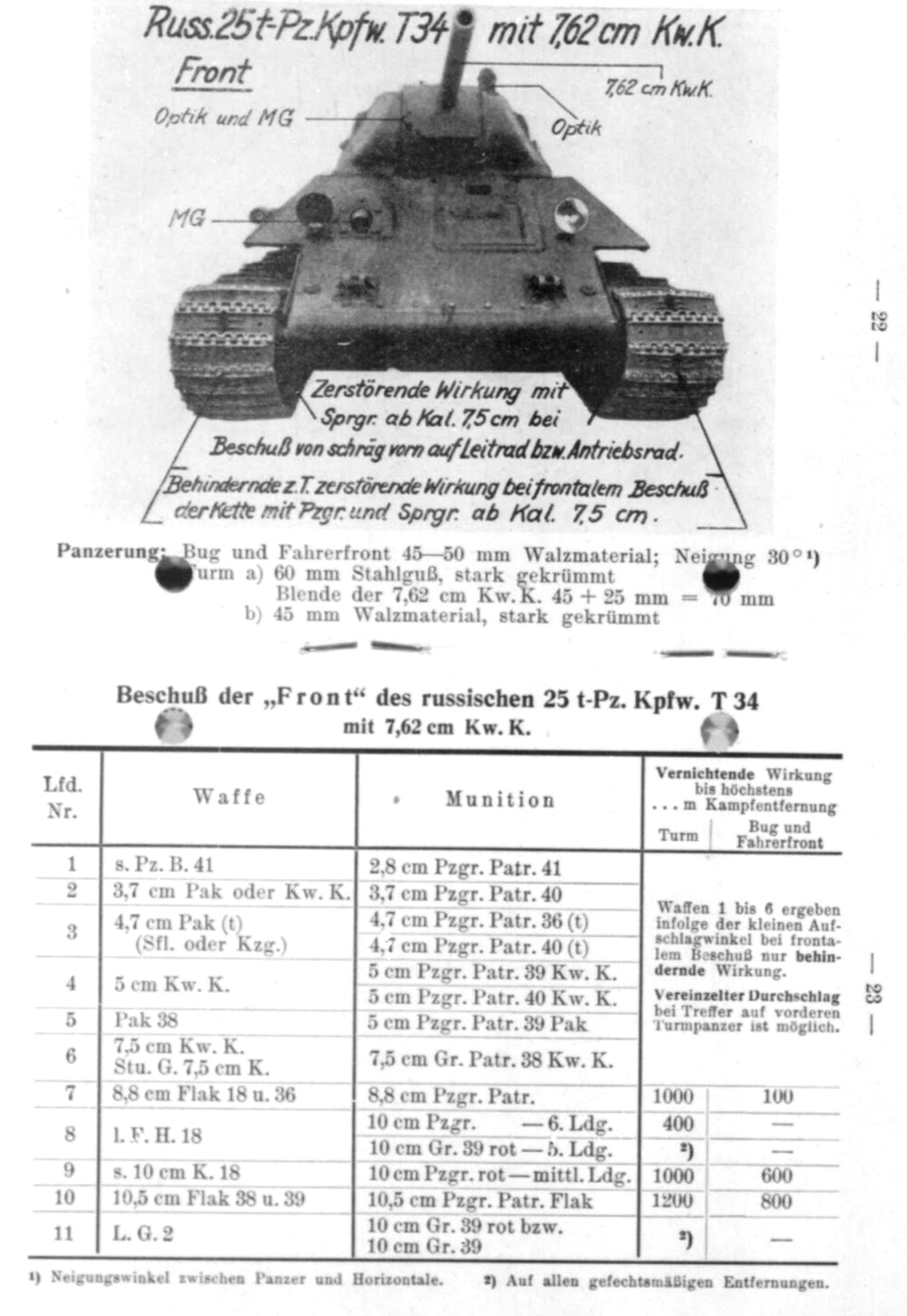
The first encounters of the German army with the T-34 tank was not too different in outcome, but left a different impression. German tank ace Otto Carius met these tanks in July of 1941 and remembered them like this:
“Another event hit us like a ton of bricks. The Russians showed up for the first time with their T-34s! The surprise was complete. How was it possible that those at the top hadn’t known about the existence of this superior tank?
The T-34 with its good armour, ideal shape, and magnificent 76.2 mm long-barreled cannon was universally feared and a threat to every German tank up until the end of the war. What were we supposed to do to these monstrosities that were being committed in quantity against us? We could only knock at the door with our cannons, inside the Russians were able to play an undisturbed hand of cards. At that time, the 37 mm Pak was still our strongest armour defeating weapon. If lucky, we could hit the T-34 on the turret ring and jam it. With a whole lot more luck, it became combat ineffective. Certainly not a very positive situation!
Our only salvation was the 88 mm Flak. Even this new Russian tank could be effectively engaged with it. We thus started paying the utmost respect to the Flak troops who previously had sometimes received a condescending smile from us.”
88 mm AA guns were indeed an effective weapon against the T-34. German instructions suggested firing the AP shell (Pzgr.Patr.) at the T-34’s turret from 1000 meters and at the hull from an even closer range: 100-800 meters. Other instructions suggested firing at 500-600 meters to be sure. 105 mm Flak 38 and Flak 39 guns could fire at the turret from 1200 m and at the hull from 800 m. The 105 mm leFH 18 howitzer and Kanone 18 gun could fire HE shells from any range. Smaller caliber guns had only a small chance to penetrate the turret armour and were only useful for suppressing inexperienced crews. 75 mm HE or larger had a chance of disabling the running gear.
Carius was not the only one who wrote about these tactics. His superiors wrote about the same techniques, but much less favourably. For example, Bundeswehr Lieutenant General Heinz Gaedcke (a Major General in the Wehrmacht) recalled:
“We really had nothing useful except the 3.7 cm anti-tank cannon, the one we later nicknamed, as enemy armour became thicker, the “Tank Door-Knocking Apparatus”. […]
The most feared — and, from our side, the most valued — instrument was the 8.8 cm. Unfortunately, this was very immobile and as big as a barn. […]
Before the war, when we saw the flak — they came in their nice steel blue Luftwaffe uniforms with tie and collar, whereas the Army only had the high collar — we always said “Here come the gentlemen soldiers. What can we expect from them in wartime?” When the need arose to use the flak in ground combat, particularly against tanks, we Army soldiers quickly reversed our too-hasty judgement. In fact, wherever there was a flak unit in the neighbourhood we always eagerly asked to have them join us. […]
But they were a high, prominent target, and were quickly recognized by Russian artillery. As a result, they suffered very high casualties, but they were always ready to go far forward to support the infantry. I can only sing their praise.”
Drawbacks of using field and anti-aircraft artillery against tanks are also outlined in a report from one of the officers of Heinz Guderian’s 4th Tank Division:
“Combat against Russian tanks using 8.8 cm AA guns or 10 cm guns cannot be sufficient on its own. Both types of guns are very bulky compared to fast tanks and in most cases were discovered, fired upon, and destroyed in the process of travel to firing positions. These unprotected guns are as large as a barn door and offer a very large and tempting target.”
Memoirs and reports by German officers highlight important points that are often ignored by fans of comparing millimetres of penetration against the thickness of armour alone. The penetration of 88 mm and larger guns was indeed high, but their mobility was very low. Anti-tank gun crews often survived thanks to the small size of their weapons and the ability relocated their gun after a few shots. Field artillery and AA gun crews had no such luxury. Their fate was shared by crews of later anti-tank guns, which may have been lower than AA guns but still impossible to move by hand.
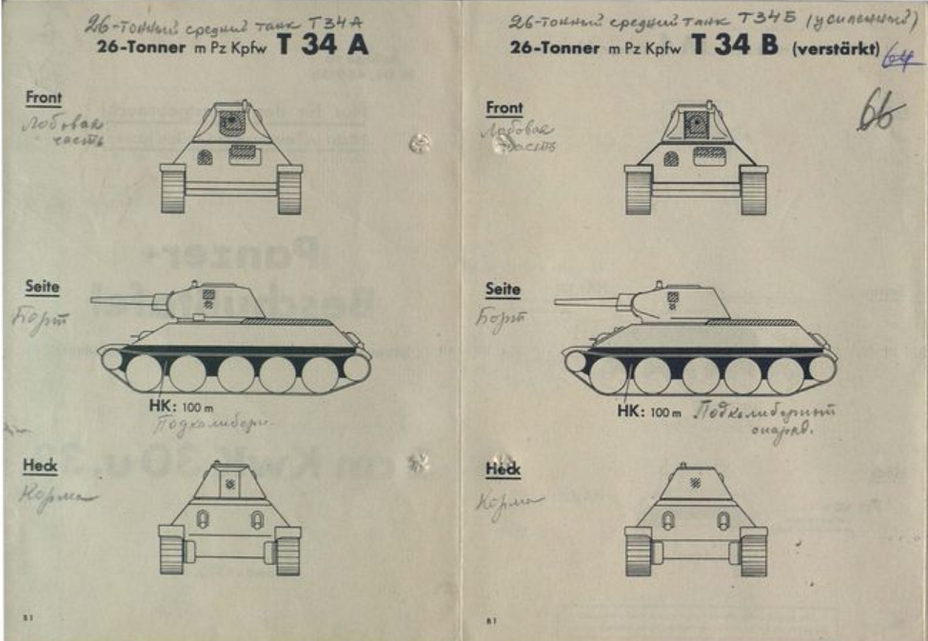
It is also hard to agree with the evaluation that German anti-tank artillery was completely helpless. It was difficult to knock out a T-34 with the 3.7 cm Pak, but there were more powerful weapons available. The 5 cm Pak 38 still couldn’t penetrate the T-34’s front armour, but could penetrate the sloped superstructure sides from 700 meters, let alone the more vulnerable vertical armour. If the gunner got lucky and didn’t hit a road wheel, then this armour could even be penetrated by the 28/20 mm s.Pz.B.41 anti-tank rifle from 400 meters.
Tank on tank
Anti-tank defenses with skillful use of ambushes and AA guns gave some results, but tank battles presented a more difficult issue. The 88 mm gun simply could not fit in a Pz.Kpfw.III or Pz.Kpfw.IV tank. There was of course the Bunkerflak 8.8 cm Flak 18 (Sfl.) auf Zugkraftwagen 12t (Sd.Kfz. 8), but this vehicle was nearly unarmoured. Tank destroyers armed with the captured 47 mm Skoda PUV vz. 36 anti-tank gun also left much to be desired when it came to armour, and the 4.7 cm Pak(t) (Sfl) auf Fgst.Pz.Kpfw.35 R 731(f) on a captured French chassis was also unreliable to boot. Attempts to deploy towed guns in the middle of a tank battle resulted in heavy losses, as mentioned above.
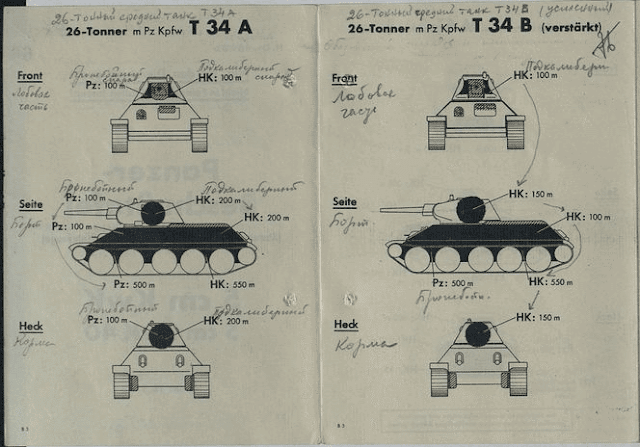
The remaining options were 37 mm German and Czech tank guns, 50 mm guns on the latest Pz.Kpfw.III models (still weaker than towed 50 mm guns) and 75 mm guns of the Pz.Kpfw.IV tanks. The situation could somewhat be improved by APCR ammunition, but it was in short supply. The aforementioned report from the 4th Tank Division states:
“Our 5 cm KwK tank guns can only penetrate weak spots in very specific conditions at very small ranges, up to 50 m. Our tanks can be penetrated at a range of hundreds of meters. […]
The high energy and fighting spirit of our earlier attacks will wane and be spent due to feelings of inadequacy. Crews know that they can be knocked out by enemy tanks at long ranges but can only have a small effect on the enemy themselves, despite the use of special ammunition at short range.”
The report author lists a number of improvements that have to be urgently developed for German fighting vehicles. The Pz.Kpfw.III needed a more powerful 50 mm gun with the same ballistics as the towed gun. The Pz.Kpfw.IV needed the “Russian 76 mm tank gun”. A tank destroyer with a 105 mm gun and towed 105 mm anti-tank guns also had to be developed. A copy of the T-34 also had to be put into production, until then, captured T-34 tanks could be used.
While waiting for a copy of the T-34 or at least its gun, clever tactics had to be invented. Since Soviet tanks could fire from a long range (various German documents give ranges between 1000 and 2000 meters) in favourable conditions (hull down, entrenched, etc), it was suicide to tackle them head on. It was also difficult to circle around them since the T-34 was faster than German tanks. Since it was only possible to penetrate a T-34 from the side and at short range, the Germans came up with the following tactics:
“1. Tie up the tank with three Pz.Kpfw.III tanks that engage in a firefight. Taking up hull down positions or moving constantly will make it harder for the enemy to fire.
2. Meanwhile, two more Pz.Kpfw.III tanks using all cover rush to the T-34 from the left and right flanks or come in from the rear and fire from a short distance using PzGr.40 shot, aiming for the sides or the rear of the tank.
3. If there is a Pz.Kpfw.IV tank among our tanks, it can be used to tie up the T-34 from the front. Using a smokescreen, the Pz.Kpfw.IV can blind the T-34 or cover the approach of other tanks. It is likely that the enemy will mistake the smoke for chemical weapons and disengage on its own.“
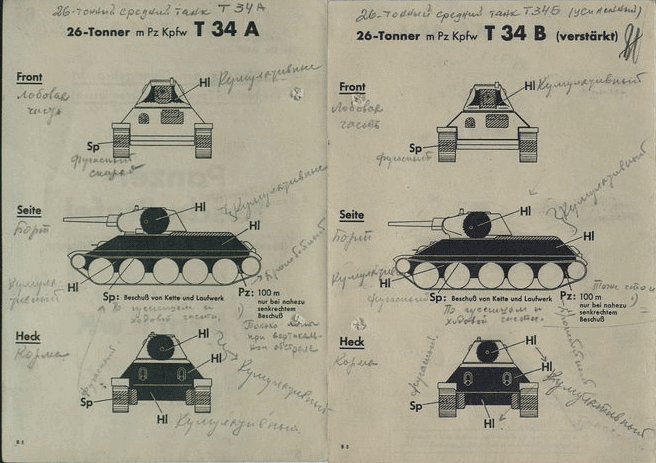
The Germans correctly identified the T-34’s weaknesses. The commander doubled as the gunner, meaning that he could not observe the battlefield and fire at the same time. Limited vision also helped. The Germans identified the presence of a commander’s cupola on their tanks as an advantage over the T-34 that had to be leveraged as much as possible.
Interestingly enough, the Red Army resorted to the same tactics two years later. Then it was the T-34’s turn to tie up Tigers from the front while an ally hit them in the side at close range.
Man versus tank
“Door knockers” and tanks with short barreled guns were not ideal weapons against the T-34 tanks, but when Soviet tanks appeared on the horizon even these were often not available. In the late war a German soldier at least had a chance to knock out an enemy tank with a Panzerfaust fired at close range from the window of a building, but fighting tanks in an empty field with only small arms was a whole different story. Nevertheless, the infantry had to come up with ways to fight tanks on its own.
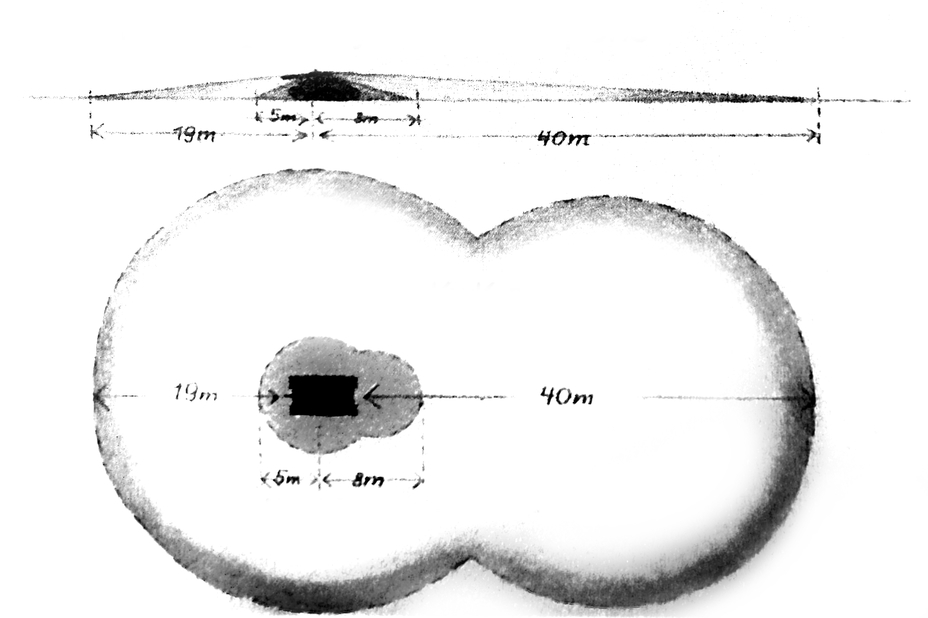
The infantry had access to armour piercing bullets. Riflemen were issued 10 rounds with S.m.K.H. bullets (Spitzgeschoss mit Kern, Hart, pointed bullet with a hard core). Machine gunners had 100 such rounds. On command from the section leader, riflemen opened fire with these bullets from up to 400 meters and machine gunners from up to 1000 meters, aiming at hatches and vision slits to force enemy commanders to retreat into their tanks. This tactic would not disable the enemy tank, but it could blind it.
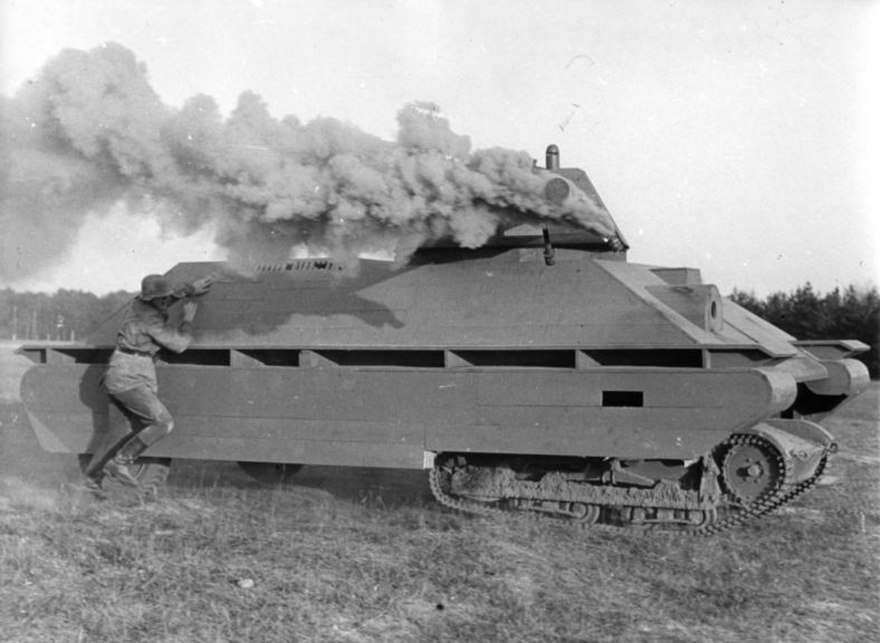
This is a topic that deserves close attention. German training highlighted that tanks are blind even if all observation devices are functional. The best way to teach an infantryman to not be afraid of tanks was to let him sit in one and try to look around. This training was applied in practice. Manuals on fighting T-34 tanks included diagrams with the vision range of the driver’s observation device, hull gunner’s sight, commander’s periscopic and telescopic sights, and the observation ports in the side of the turret. The dead zones of the tank’s armament were also indicated. An infantryman was safe from the T-34’s main gun and machine gun if he was within 19 meters of the front of the tank or 40 meters from the rear. At a range of 5 meters in the front and 8 meters in the back he was safe from the crew’s personal weapons. Just like in the Red Army, German troops were instructed to hide in a trench or foxhole and wait until the enemy tanks came close.
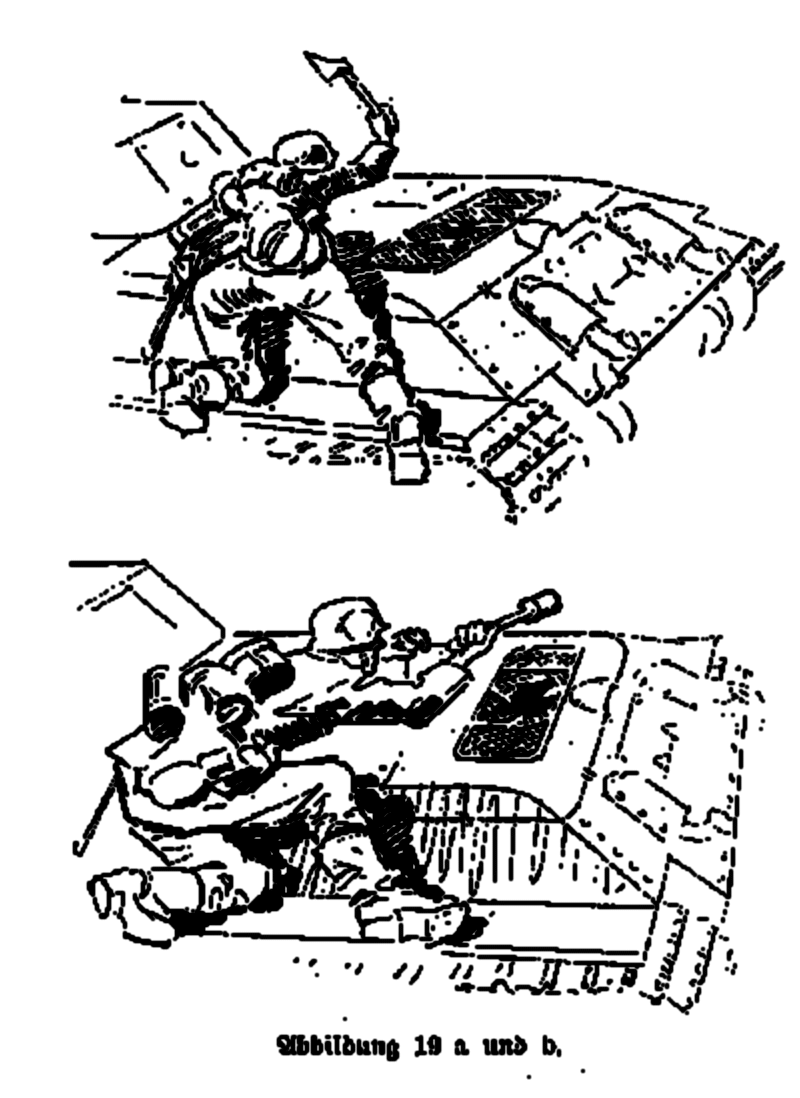
Traditional infantry anti-tank weapons, Molotov cocktails or grenades, could be used once the soldiers got close. German instructions suggested tying two grenades together with string and looping it around the gun barrel. Fragmentation grenades could damage the gun barrel or the sights. Smoke grenades would blind the crew for a short time. If the tank was disabled then smoke grenades thrown on top of it could also force the crew to exit the tank, otherwise they just rolled off when the tank moved.
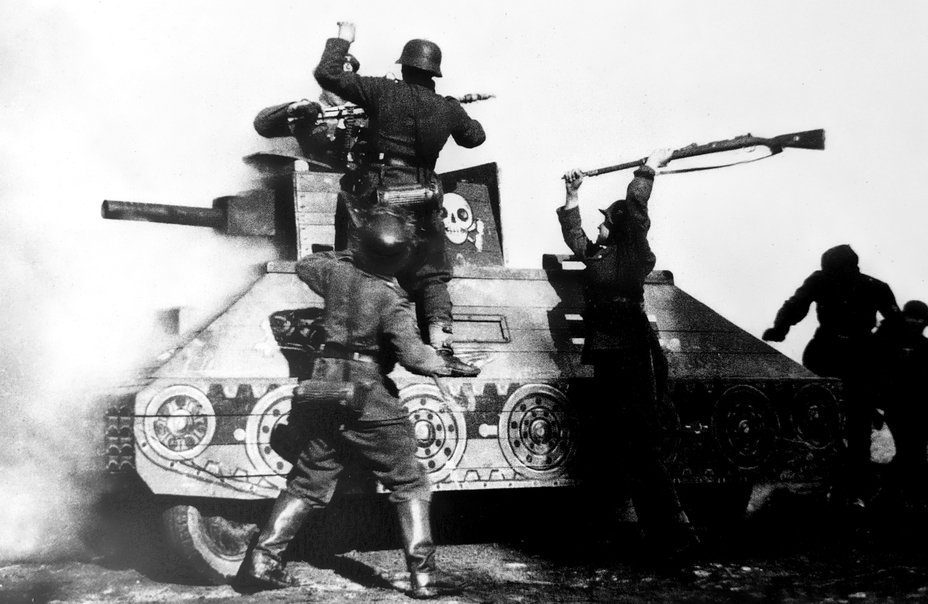
There were also stranger methods recommended for fighting T-34 tanks. Infantrymen were told to climb up on the engine deck, chop through the louvres above the transmission compartment, and throw a grenade or pour gasoline inside. If one didn’t have an axe or extra gasoline, he could grab a bucket of mud, climb up on the tank, and cover up its observation devices. The odds of success of this questionable venture were not stated in the manual, nor was there any indication of how to deal with enemy tanks or accompanying infantry that would no doubt be interested in this performance. Nevertheless, instructions like these fought against the fear of “26 ton Christie tanks” that the Germans saw behind every bush in the summer of 1941.
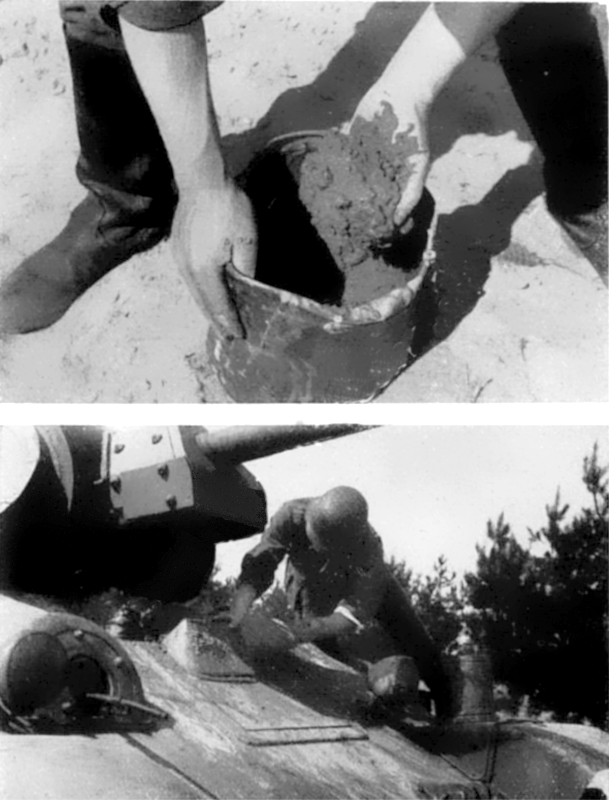
The T-34 had exceptional characteristics for its time, but it had its weaknesses like any other tank. As with the Matilda, the Germans quickly discovered these weaknesses and developed countermeasures, but while the Queen of the Desert reigned over the Italians for only a few months, the T-34 maintained its reputation of a dangerous enemy even after 1942 when there were plenty of German tanks that could face off against it. The techniques that proved themselves in France were now considered flawed at best and suicidal at worst. The key to the T-34’s success was not only its technical characteristics, but the rapidly growing expertise of the Red Army.
Sources:
-
A. Ulanov, D. Shein, The T-34 Goes to War
-
O. Carius, Tigers in the Mud
-
Feindpanzer Teil 1: T34 Bildheft zugleich Erläuterung zur Lichtbildreihe 146a
-
Translation of Taped Conversation with Lieutenant General Heinz Gaedcke, 12 April 1979, Columbus Laboratories Tactical Technology Center.
-
Documents from the Central Archive of the Ministry of Defense of the Russian Federation







